Photolysis and TiO2 Photocatalytic Treatment under UVC/VUV Irradiation for Simultaneous Degradation of Pesticides and Microorganisms
Abstract
1. Introduction
2. Materials and Methods
2.1. Chemicals, Reagents, and Microbial Strains
2.2. Photolytic and Photocatalytic Treatments
2.2.1. Preparation of Pesticide Solutions
2.2.2. Preparation of Microbial Suspensions
2.2.3. Degradation Treatments for Pesticides and Microorganisms in Aqueous Solutions
2.3. Photolytic and Photocatalytic Treatments for Residual Pesticides and Microorganisms on Fresh Cut Carrots
2.3.1. Preparation of Fresh Cut Carrots as a Fresh Produce Surface Model
2.3.2. Artificial Contamination of Fresh Cut Carrots with Pesticides and Microorganisms
2.3.3. Degradation Treatments for Residual Pesticides and Microorganisms Inoculated on Fresh Cut Carrots
2.4. Analysis of Pesticides
2.5. Kinetic Study of Pesticide Degradation
2.6. Microbiological Analysis
2.7. Statistical Analysis
3. Results and Discussion
3.1. Effects of the UV Light Source and TiO2 Photocatalysis on Degradation of Pesticides
3.2. Effects of Aeration on the Pesticide Degradation Efficiency
3.3. Effects of the UV Light Source and TiO2 Photocatalysis on Inactivation of Microorganisms
3.4. Removal of Residual Pesticides on Fresh Cut Carrots under Combined UV and Combined UV-TiO2 Treatments
3.5. Inactivation of Microorganisms on Fresh Cut Carrots with Combined UV and Combined UV-TiO2 Treatments
4. Conclusions
Author Contributions
Funding
Conflicts of Interest
References
- Callejón, R.M.; Rodriguez-Naranjo, M.I.; Ubeda, C.; Hornedo-Ortega, R.; Garcia-Parrilla, M.C.; Troncoso, A.M. Reported foodborne outbreaks due to fresh produce in the United States and European Union: Trends and causes. Foodborne Pathog. Dis. 2015, 12, 32–38. [Google Scholar] [CrossRef] [PubMed]
- Bhilwadikar, T.; Pounraj, S.; Manivannan, S.; Rastogi, N.K.; Negi, P.S. Decontamination of microorganisms and pesticides from fresh fruits and vegetables: A comprehensive review from common household processes to modern techniques. Compr. Rev. Food Sci. Food Saf. 2019, 18, 1003–1038. [Google Scholar] [CrossRef]
- Aktar, W.; Sengupta, D.; Chowdhury, A. Impact of pesticides use in agriculture: Their benefits and hazards. Interdiscip. Toxicol. 2009, 2, 1–12. [Google Scholar] [CrossRef] [PubMed]
- Damalas, C.A.; Eleftherohorinos, I.G. Pesticide exposure, safety issues, and risk assessment indicators. Int. J. Environ. Res. Public Health 2011, 8, 1402–1419. [Google Scholar] [CrossRef] [PubMed]
- Bonnechère, A.; Hanot, V.; Jolie, R.; Hendrickx, M.; Bragard, C.; Bedoret, T.; Van Loco, J. Effect of household and industrial processing on levels of five pesticide residues and two degradation products in spinach. Food Control 2012, 25, 397–406. [Google Scholar] [CrossRef]
- Mahmood, I.; Imadi, S.R.; Shazadi, K.; Gul, A.; Hakeem, K.R. Effects of pesticides on environment. In Plant, Soil and Microbes; Hakeem, K., Akhtar, M., Abdullah, S., Eds.; Springer International Publishing: Berlin, Germany, 2016; pp. 253–269. [Google Scholar]
- Nicolopoulou-Stamati, P.; Maipas, S.; Kotampasi, C.; Stamatis, P.; Hens, L. Chemical pesticides and human health: The urgent need for a new concept in agriculture. Front. Public Health 2016, 4, 148. [Google Scholar] [CrossRef]
- Maffei, D.F.; Batalha, E.Y.; Landgraf, M.; Schaffner, D.W.; Franco, B.D. Microbiology of organic and conventionally grown fresh produce. Braz. J. Microbiol. 2016, 47, 99–105. [Google Scholar] [CrossRef]
- Wedge, D.E.; Smith, B.J.; Quebedeaux, J.P.; Constantin, R.J. Fungicide management strategies for control of strawberry fruit rot diseases in Louisiana and Mississippi. Crop Prot. 2007, 26, 1449–1458. [Google Scholar] [CrossRef]
- Munitz, M.S.; Resnik, S.L.; Montti, M.I.; Medina, M.B. Occurrence of fungicide residues on Argentinean blueberry fruit and juice samples. SDRP J. Food Sci. Technol. 2016, 1, 1–5. [Google Scholar]
- Avenot, H.F.; Michailides, T.J. Detection of isolates of Alternaria alternata with multiple-resistance to fludioxonil, cyprodinil, boscalid and pyraclostrobin in California pistachio orchards. Crop Prot. 2015, 78, 214–221. [Google Scholar] [CrossRef]
- Jankowska, M.; Kaczynski, P.; Hrynko, I.; Lozowicka, B. Dissipation of six fungicides in greenhouse-grown tomatoes with processing and health risk. Environ. Sci. Pollut. Res. 2016, 23, 11885–11900. [Google Scholar] [CrossRef] [PubMed]
- McDaniel, C.; Jadeja, R. A review of fresh produce outbreaks, current interventions, food safety concerns and potential benefits of novel antimicrobial sodium acid sulfate. MOJ Food Process. Technol. 2019, 7, 59–67. [Google Scholar]
- Katagi, T. Direct photolysis mechanism of pesticides in water. J. Pestic. Sci. 2018, 43, 57–72. [Google Scholar] [CrossRef] [PubMed]
- Burrows, H.D.; Santaballa, J.A.; Steenken, S. Reaction pathways and mechanisms of photodegradation of pesticides. J. Photochem. Photobiol. B Biol. 2002, 67, 71–108. [Google Scholar] [CrossRef]
- Cuerda-Correa, E.M.; Alexandre-Franco, M.F.; Fernández-González, C. Advanced oxidation processes for the removal of antibiotics from water. An Overview. Water 2020, 12, 102. [Google Scholar] [CrossRef]
- Deng, Y.; Zhao, R. Advanced oxidation processes (AOPs) in wastewater treatment. Curr. Pollut. Rep. 2015, 1, 167–176. [Google Scholar] [CrossRef]
- Chen, J.; He, Z.; Ji, Y.; Li, G.; An, T.; Choi, W. OH radicals determined photocatalytic degradation mechanisms of gaseous styrene in TiO2 system under 254 nm versus 185 nm irradiation: Combined experimental and theoretical studies. Appl. Catal. B Environ. 2019, 257, 117912. [Google Scholar] [CrossRef]
- Szeto, W.; Li, J.; Huang, H.; Leung, D.Y. VUV/TiO2 photocatalytic oxidation process of methyl orange and simultaneous utilization of the lamp-generated ozone. Chem. Eng. Sci. 2018, 177, 380–390. [Google Scholar] [CrossRef]
- de Oliveira Schwaickhardt, R.; Machado, Ê.L.; Lutterbeck, C.A. Combined use of VUV and UVC photoreactors for the treatment of hospital laundry wastewaters: Reduction of load parameters, detoxification and life cycle assessment of different configurations. Sci. Total Environ. 2017, 590, 233–241. [Google Scholar] [CrossRef]
- Giri, R.R.; Ozaki, H.; Guo, X.; Takanami, R.; Taniguchi, S. Efficacies of UVC and VUV photolysis for mineralization of pharmaceutical compounds in mixed aqueous solution. Desalin. Water Treat. 2015, 54, 3625–3631. [Google Scholar] [CrossRef]
- Tasaki, T.; Wada, T.; Fujimoto, K.; Kai, S.; Ohe, K.; Oshima, T.; Baba, Y.; Kukizaki, M. Degradation of methyl orange using short-wavelength UV irradiation with oxygen microbubbles. J. Hazard. Mater. 2009, 162, 1103–1110. [Google Scholar] [CrossRef] [PubMed]
- Huang, H.; Lu, H.; Huang, H.; Wang, L.; Zhang, J.; Leung, D.Y. Recent development of VUV-based processes for air pollutant degradation. Front. Environ. Sci. 2016, 4, 17. [Google Scholar] [CrossRef]
- Lorret, O.; Francová, D.; Waldner, G.; Stelzer, N. W-doped titania nanoparticles for UV and visible-light photocatalytic reactions. Appl. Catal. B Environ. 2009, 91, 39–46. [Google Scholar] [CrossRef]
- Pekakis, P.A.; Xekoukoulotakis, N.P.; Mantzavinos, D. Treatment of textile dyehouse wastewater by TiO2 photocatalysis. Water Res. 2006, 40, 1276–1286. [Google Scholar] [CrossRef] [PubMed]
- Lee, M.; Shahbaz, H.M.; Kim, J.U.; Lee, H.; Lee, D.U.; Park, J. Efficacy of UV-TiO2 photocatalysis technology for inactivation of Escherichia coli K12 on the surface of blueberries and a model agar matrix and the influence of surface characteristics. Food Microbiol. 2018, 76, 526–532. [Google Scholar] [CrossRef]
- Wang, S.; Wang, J.; Wang, T.; Li, C.; Wu, Z. Effects of ozone treatment on pesticide residues in food: A review. Int. J. Food Sci. Tech. 2019, 54, 301–312. [Google Scholar] [CrossRef]
- Farha, W.; Abd El-Aty, A.M.; Rahman, M.M.; Jeong, J.H.; Shin, H.C.; Wang, J.; Shim, J.H. Analytical approach, dissipation pattern and risk assessment of pesticide residue in green leafy vegetables: A comprehensive review. Biomed. Chromatogr. 2018, 32, e4134. [Google Scholar] [CrossRef]
- CODEX Alimentarius International Food Standards. 2020. Available online: http://www.fao.org/fao-who-codexalimentarius/codex-texts/dbs/pestres/pesticides/en/ (accessed on 22 June 2020).
- Zeng, L.R.; Shi, L.H.; Meng, X.G.; Xu, J.; Jia, G.F.; Gui, T.; Zhang, Y.P.; Hu, D.Y. Evaluation of photolysis and hydrolysis of pyraclostrobin in aqueous solutions and its degradation products in paddy water. J. Environ. Sci. Heal. B 2019, 54, 317–325. [Google Scholar] [CrossRef] [PubMed]
- Lassalle, Y.; Kinani, A.; Rifai, A.; Souissi, Y.; Clavaguera, C.; Bourcier, S.; Jaber, F.; Bouchonnet, S. UV-visible degradation of boscalid–structural characterization of photoproducts and potential toxicity using in silico tests. Rapid Commun. Mass Spectrom. 2014, 28, 1153–1163. [Google Scholar] [CrossRef]
- Apell, J.N.; Pflug, N.C.; McNeill, K. Photodegradation of Fludioxonil and Other Pyrroles: The Importance of Indirect Photodegradation for Understanding Environmental Fate and Photoproduct Formation. Environ. Sci. 2019, 53, 11240–11250. [Google Scholar] [CrossRef]
- Chastain, J.; Ter Halle, A.; de Sainte Claire, P.; Voyard, G.; Traikïa, M.; Richard, C. Phototransformation of azoxystrobin fungicide in organic solvents. Photoisomerization vs. photodegradation. Photochem. Photobiol. Sci. 2013, 12, 2076–2083. [Google Scholar] [CrossRef]
- US EPA (United States Environmental Protection Agency). Pesticide Fact Sheet. 2003. Available online: https://www3.epa.gov/pesticides/chem_search/reg_actions/registration/fs_PC-128008_01-Jul-03.pdf (accessed on 20 April 2020).
- Food Safety Commission. Evaluation Report BOSCALID. 2004. Available online: https://www.fsc.go.jp/english/evaluationreports/pesticide/boscalid_full_170411.pdf (accessed on 13 June 2020).
- Finalised in the Standing Committee on the Food Chain and Animal Health at Its Meeting on 22 January 2008 in View of the Inclusion of Boscalid in Annex I of Council Directive 91/414/EEC; Review Report for the Active Substance Boscalid; European Commission: Brussels, Belgium, 2008.
- Lagunas-Allué, L.; Martínez-Soria, M.T.; Sanz-Asensio, J.; Salvador, A.; Ferronato, C.; Chovelon, J.M. Photocatalytic degradation of boscalid in aqueous titanium dioxide suspension: Identification of intermediates and degradation pathways. Appl. Catal. B-Environ. 2010, 98, 122–131. [Google Scholar] [CrossRef]
- Lagunas-Allué, L.; Martínez-Soria, M.T.; Sanz-Asensio, J.; Salvador, A.; Ferronato, C.; Chovelon, J.M. Degradation intermediates and reaction pathway of pyraclostrobin with TiO2 photocatalysis. Appl. Catal. B Environ. 2012, 115, 285–293. [Google Scholar] [CrossRef]
- Brame, J.; Long, M.; Li, Q.; Alvarez, P. Inhibitory effect of natural organic matter or other background constituents on photocatalytic advanced oxidation processes: Mechanistic model development and validation. Water Res. 2015, 84, 362–371. [Google Scholar] [CrossRef] [PubMed]
- Lhomme, L.; Brosillon, S.; Wolbert, D. Photocatalytic degradation of pesticides in pure water and a commercial agricultural solution on TiO2 coated media. Chemosphere 2008, 70, 381–386. [Google Scholar] [CrossRef] [PubMed]
- Konstantinou, I.K.; Albanis, T.A. TiO2-assisted photocatalytic degradation of azo dyes in aqueous solution: Kinetic and mechanistic investigations: A review. Appl. Catal. B Environ. 2004, 49, 1–14. [Google Scholar] [CrossRef]
- Machuca-Martínez, F.; Colina-Márquez, J.Á. Effect of the initial pH and the catalyst concentration on TiO2-based photocatalytic degradation of three commercial pesticides. Ing. Desarro. 2011, 29, 84–100. [Google Scholar]
- Batakliev, T.; Georgiev, V.; Anachkov, M.; Rakovsky, S. Ozone decomposition. Interdiscip. Toxicol. 2014, 7, 47–59. [Google Scholar] [CrossRef]
- Von Gunten, U. Ozonation of drinking water: Part I. Oxidation kinetics and product formation. Water Res. 2003, 37, 1443–1467. [Google Scholar] [CrossRef]
- Velioglu, Y.S.; ERGEN, Ş.F.; Aksu, P.; Altındağ, A. Effects of Ozone Treatment on the Degradation and Toxicity of Several Pesticides in Different Grou. J. Agric. Sci. 2018, 24, 245–255. [Google Scholar] [CrossRef]
- Misra, N.N.; Pankaj, S.K.; Walsh, T.; O’Regan, F.; Bourke, P.; Cullen, P.J. In-package nonthermal plasma degradation of pesticides on fresh produce. J. Hazard. Mater. 2014, 271, 33–40. [Google Scholar] [CrossRef] [PubMed]
- Jabesa, A.; Ghosh, P. Removal of diethyl phthalate from water by ozone microbubbles in a pilot plant. J. Environ. Manag. 2016, 180, 476–484. [Google Scholar] [CrossRef] [PubMed]
- Nawawi, W.I.; Zaharudin, R.; Zuliahani, A.; Shukri, D.S.; Azis, T.F.; Razali, Z. Immobilized TiO2-polyethylene glycol: Effects of aeration and pH of methylene blue dye. Appl. Sci. 2017, 7, 508. [Google Scholar] [CrossRef]
- Han, W.; Zhang, P.; Zhu, W.; Yin, J.; Li, L. Photocatalysis of p-chlorobenzoic acid in aqueous solution under irradiation of 254 nm and 185 nm UV light. Water Res. 2004, 38, 4197–4203. [Google Scholar] [CrossRef]
- Zoschke, K.; Börnick, H.; Worch, E. Vacuum-UV radiation at 185 nm in water treatment—A review. Water Res. 2014, 52, 131–145. [Google Scholar] [CrossRef]
- Dai, T.; Vrahas, M.S.; Murray, C.K.; Hamblin, M.R. Ultraviolet C irradiation: An alternative antimicrobial approach to localized infections. Expert Rev. Anti-Infect. Ther. 2012, 10, 185–195. [Google Scholar]
- Li, B.; Logan, B.E. Bacterial adhesion to glass and metal-oxide surfaces. Colloids Surf. B Biointerfaces 2004, 36, 81–90. [Google Scholar] [CrossRef]
- Hu, C.; Hu, X.; Guo, J.; Qu, J. Efficient destruction of pathogenic bacteria with NiO/SrBi2O4 under visible light irradiation. Environ. Sci. Technol. 2006, 40, 5508–5513. [Google Scholar] [CrossRef] [PubMed]
- Cohen-Yaniv, V.; Narkis, N.; Armon, R. Photocatalytic inactivation of Flavobacterium and E. coli in water by a continuous stirred tank reactor (CSTR) fed with suspended/immobilised TiO2 medium. Water Sci. Technol. 2008, 58, 247–252. [Google Scholar]
- Van Grieken, R.; Marugán, J.; Pablos, C.; Furones, L.; López, A. Comparison between the photocatalytic inactivation of Gram-positive E. faecalis and Gram-negative E. coli faecal contamination indicator microorganisms. Appl. Catal. B Environ. 2010, 100, 212–220. [Google Scholar]
- Yoo, S.; Ghafoor, K.; Kim, S.; Sun, Y.W.; Kim, J.U.; Yang, K.; Lee, D.-U.; Shahbaz, H.M.; Park, J. Inactivation of pathogenic bacteria inoculated onto a Bacto™ agar model surface using TiO2-UVC photocatalysis, UVC and chlorine treatments. J. Appl. Microbiol. 2015, 119, 688–696. [Google Scholar] [CrossRef][Green Version]
- Bogdan, J.; Zarzyńska, J.; Pławińska-Czarnak, J. Comparison of infectious agents susceptibility to photocatalytic effects of nanosized titanium and zinc oxides: A practical approach. Nanoscale Res. Lett. 2015, 10, 1–15. [Google Scholar] [CrossRef] [PubMed]
- Adhikari, A.; Syamaladevi, R.M.; Killinger, K.; Sablani, S.S. Ultraviolet-C light inactivation of Escherichia coli O157: H7 and Listeria monocytogenes on organic fruit surfaces. Int. J. Food Microbiol. 2015, 210, 136–142. [Google Scholar] [CrossRef] [PubMed]
- Shahbaz, H.M.; Kim, S.; Kim, J.U.; Park, D.; Lee, M.; Lee, D.-U.; Park, J. Inactivation of Salmonella Typhimurium in fresh cherry tomatoes using combined treatment of UV-TiO2 photocatalysis and high hydrostatic pressure. Food Sci. Biotechnol. 2018, 27, 1531–1539. [Google Scholar] [CrossRef] [PubMed]
- Mukhopadhyay, S.; Ukuku, D.O.; Juneja, V.K. Effects of integrated treatment of nonthermal UV-C light and different antimicrobial wash on Salmonella enterica on plum tomatoes. Food Control 2015, 56, 147–154. [Google Scholar] [CrossRef]
- Kim, S.H.; Shahbaz, H.M.; Park, D.; Chun, S.; Lee, W.; Oh, J.W.; Lee, D.U.; Park, J. A combined treatment of UV-assisted TiO2 photocatalysis and high hydrostatic pressure to inactivate internalized murine norovirus. Innov. Food Sci. Emerg. Technol. 2017, 39, 188–196. [Google Scholar] [CrossRef]
- Shahbaz, H.M.; Ryoo, H.; Kim, J.U.; Kim, S.; Lee, D.U.; Ghafoor, K.; Park, J. Effects of UV-C in a Teflon-coil and high hydrostatic pressure combined treatment for maintenance of the characteristic quality of dongchimi (watery radish kimchi) during room temperature storage. J. Food Process. Preserv. 2017, 41, e13057. [Google Scholar] [CrossRef]
- Guo, Q.; Zhou, C.; Ma, Z.; Yang, X. Fundamentals of TiO2 photocatalysis: Concepts, mechanisms, and challenges. Adv. Mater. 2019, 31, 1901997. [Google Scholar] [CrossRef]
- Foster, H.A.; Ditta, I.B.; Varghese, S.; Steele, A. Photocatalytic disinfection using titanium dioxide: Spectrum and mechanism of antimicrobial activity. Appl. Microbiol. Biotechnol. 2011, 90, 1847–1868. [Google Scholar] [CrossRef]
- Yemmireddy, V.K.; Hung, Y.C. Using photocatalyst metal oxides as antimicrobial surface coatings to ensure food safety—Opportunities and challenges. Compr. Rev. Food Sci. Food Saf. 2017, 16, 617–631. [Google Scholar] [CrossRef]
- Kim, Y.; Choi, Y.; Kim, S.; Park, J.; Chung, M.; Song, K.B.; Hwang, I.; Kwon, K.; Park, J. Disinfection of iceberg lettuce by titanium dioxide–UV photocatalytic reaction. J. Food Prot. 2009, 72, 1916–1922. [Google Scholar] [CrossRef] [PubMed]
- Subramonian, W.; Wu, T.Y. Effect of enhancers and inhibitors on photocatalytic sunlight treatment of methylene blue. Water Air Soil Pollut. 2014, 225, 1922. [Google Scholar] [CrossRef]

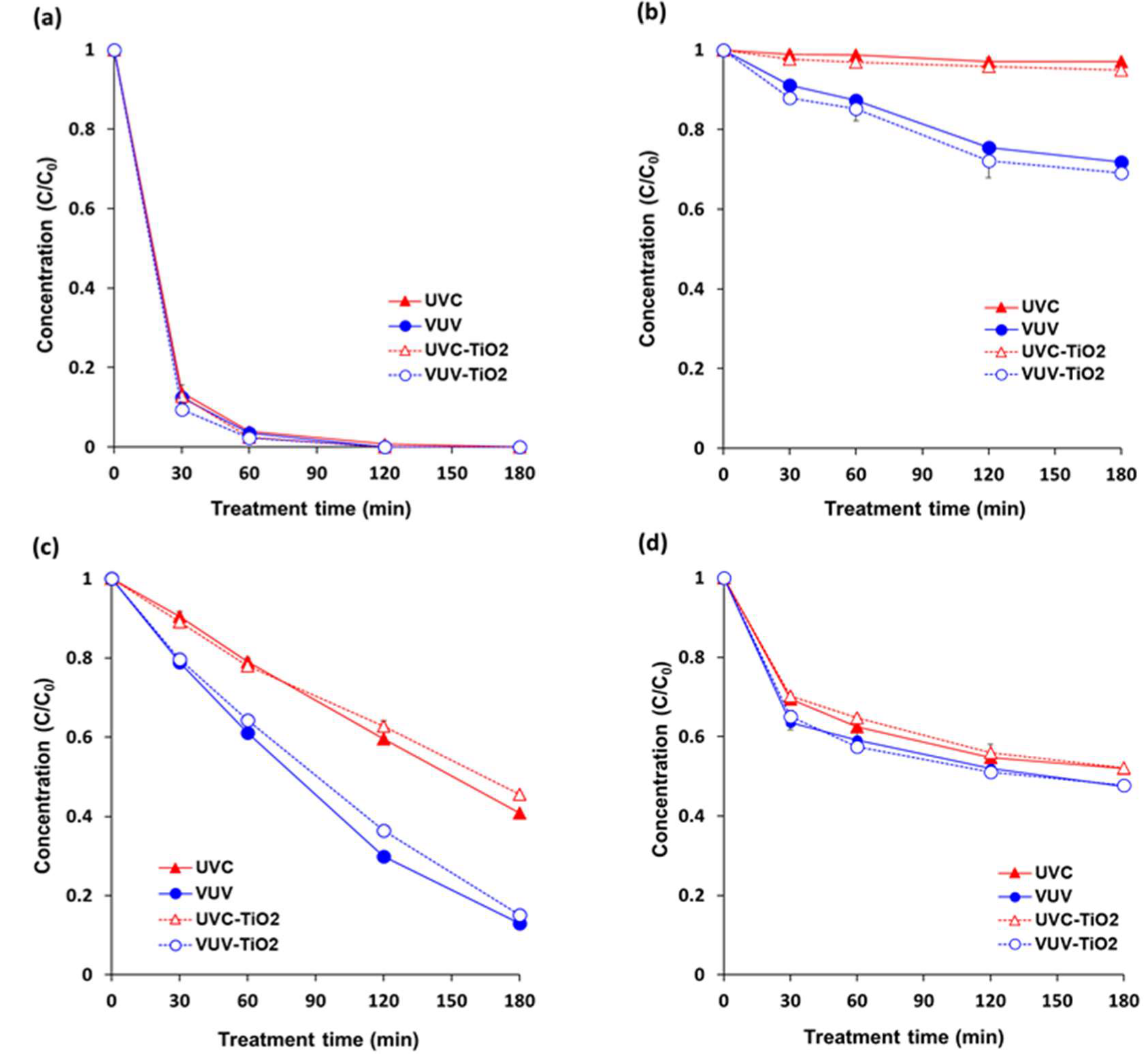


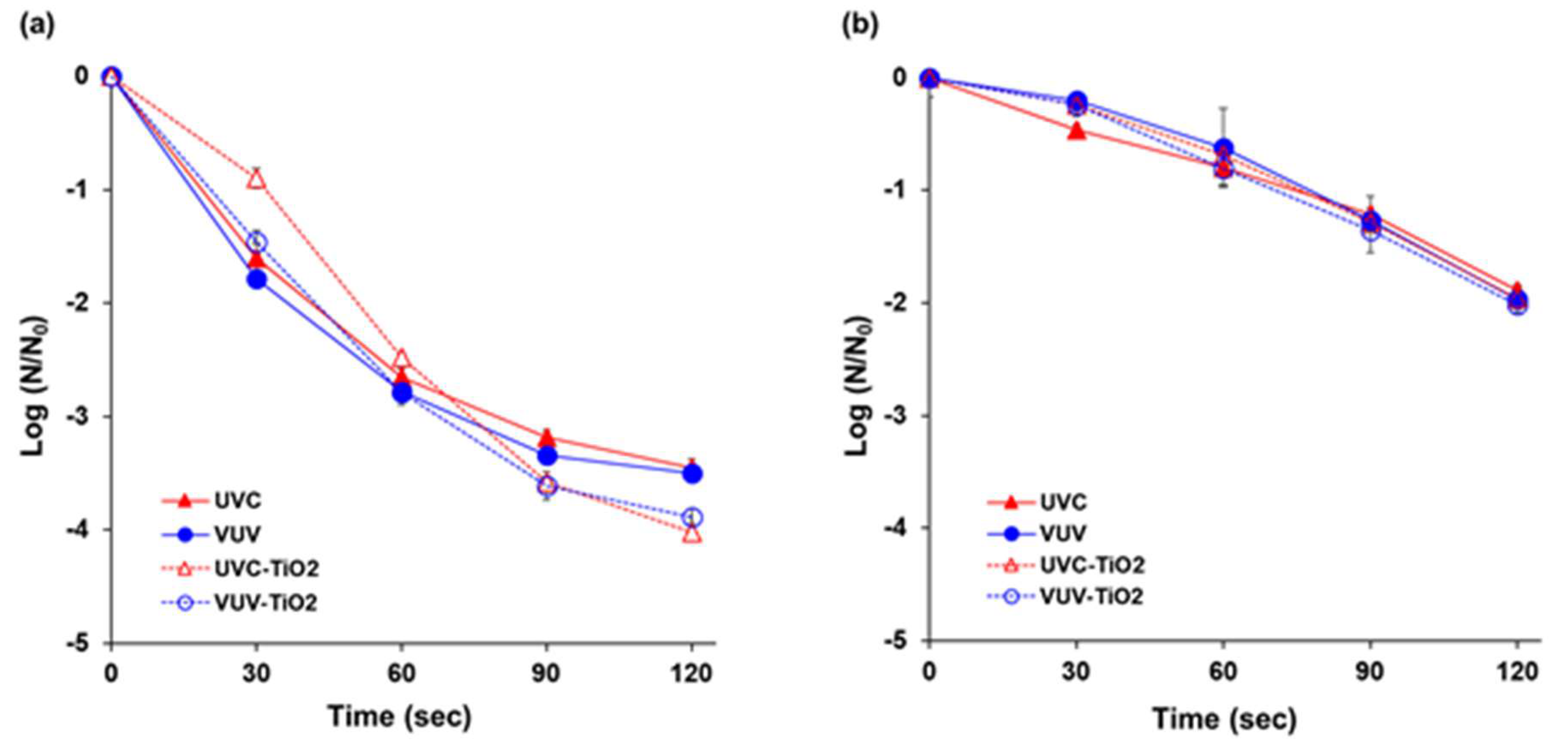

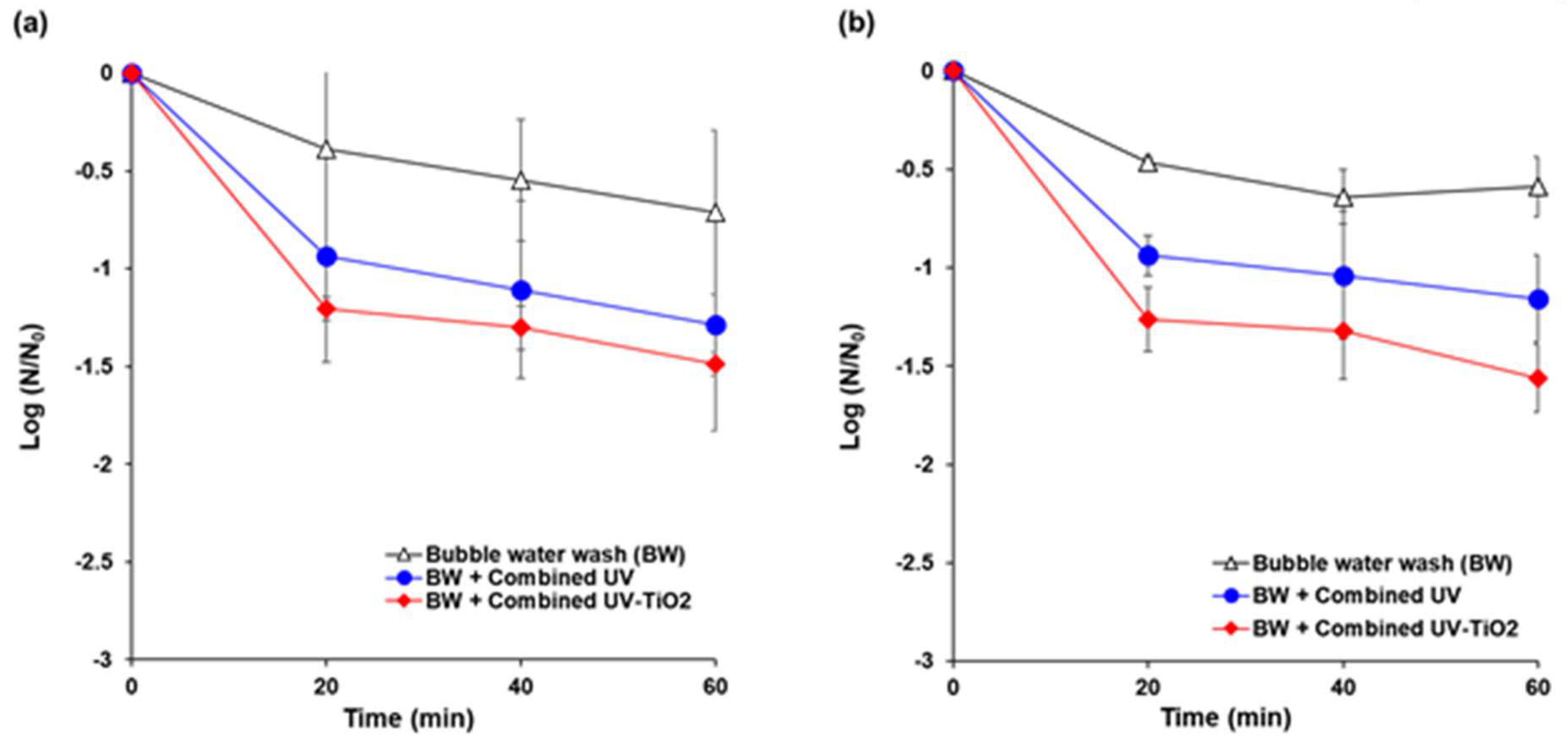
| Pesticides | Pyraclostrobin | Boscalid | Fludioxonil | Azoxystrobin |
|---|---|---|---|---|
| Structure |  | 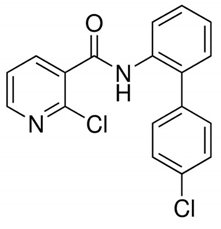 |  | 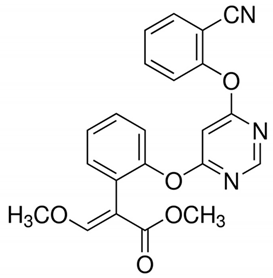 |
| IUPAC name | methyl N-{2-[1-(4-chlorophenyl)-1H-pyrazol3-yloxymethyl] phenyl}(N-methoxy) carbamate | 2-chloro-N-(4’-chlorobiphenyl-2-yl)nicotinamide | 4-(2,2-difluoro-1,3-benzodioxol-4-yl) pyrrole-3-carbonitrile | Methyl (2E)-2-(2-{[6-(2-cyanophenoxy)pyrimidin-4-yl]oxy}phenyl)-3-methoxyacrylate |
| Molecular formula | C19H18ClN3O4 | C18H12Cl2N2O | C12H6F2N2O2 | C22H17N3O5 |
| Molecular weight | 387.82 | 343.21 | 248.18 | 403.38 |
| V.P | 2.6 × 10−5 mPa (20 °C) | 7.2 × 10−4 mPa (20 °C) | 3.9 × 10−4 mPa (25 °C) | 1.1 × 10−7 mPa (20 °C) |
| Solubility | In water 1.9 mg/L (20~25 °C). | In water 4.6 mg/L (20~25 °C) | In water 1.8 mg/L (20~25 °C) | In water 6 mg/L (20 °C) |
| Pyraclostrobin | Boscalid | Fludioxonil | Azoxystrobin | |||||||||
|---|---|---|---|---|---|---|---|---|---|---|---|---|
| Rate Constant | K0 | K1 | K2 | K0 | K1 | K2 | K0 | K1 | K2 | K0 | K1 | K2 |
| (R2) | (R2) | (R2) | (R2) | (R2) | (R2) | (R2) | (R2) | (R2) | (R2) | (R2) | (R2) | |
| Single solution | 0.4888 | 1.8978 | 21.753 | 0.0775 | 0.0935 | 0.1141 | 0.213 | 0.4556 | 1.2681 | 0.1184 | 0.1719 | 0.2606 |
| (0.8051) | (0.9809) | (0.9051) | (0.9560) | (0.9600) | (0.9590) | (0.9926) | (0.9092) | (0.7503) | (0.7920) | (0.8635) | (0.9263) | |
| Cocktail solution | 0.2088 | 0.7035 | 4.2827 | 0.0014 | 0.0144 | 0.0148 | 0.0435 | 0.0480 | 0.0531 | 0.1278 | 0.1921 | 0.3043 |
| (0.6975) | (0.9394) | (0.9787) | (0.9753) | (0.9759) | (0.9765) | (0.9650) | (0.9714) | (0.9763) | (0.8221) | (0.8992) | (0.9591) | |
© 2020 by the authors. Licensee MDPI, Basel, Switzerland. This article is an open access article distributed under the terms and conditions of the Creative Commons Attribution (CC BY) license (http://creativecommons.org/licenses/by/4.0/).
Share and Cite
Choi, S.W.; Shahbaz, H.M.; Kim, J.U.; Kim, D.-H.; Yoon, S.; Jeong, S.H.; Park, J.; Lee, D.-U. Photolysis and TiO2 Photocatalytic Treatment under UVC/VUV Irradiation for Simultaneous Degradation of Pesticides and Microorganisms. Appl. Sci. 2020, 10, 4493. https://doi.org/10.3390/app10134493
Choi SW, Shahbaz HM, Kim JU, Kim D-H, Yoon S, Jeong SH, Park J, Lee D-U. Photolysis and TiO2 Photocatalytic Treatment under UVC/VUV Irradiation for Simultaneous Degradation of Pesticides and Microorganisms. Applied Sciences. 2020; 10(13):4493. https://doi.org/10.3390/app10134493
Chicago/Turabian StyleChoi, Sung Won, Hafiz Muhammad Shahbaz, Jeong Un Kim, Da-Hyun Kim, Sohee Yoon, Se Ho Jeong, Jiyong Park, and Dong-Un Lee. 2020. "Photolysis and TiO2 Photocatalytic Treatment under UVC/VUV Irradiation for Simultaneous Degradation of Pesticides and Microorganisms" Applied Sciences 10, no. 13: 4493. https://doi.org/10.3390/app10134493
APA StyleChoi, S. W., Shahbaz, H. M., Kim, J. U., Kim, D.-H., Yoon, S., Jeong, S. H., Park, J., & Lee, D.-U. (2020). Photolysis and TiO2 Photocatalytic Treatment under UVC/VUV Irradiation for Simultaneous Degradation of Pesticides and Microorganisms. Applied Sciences, 10(13), 4493. https://doi.org/10.3390/app10134493









